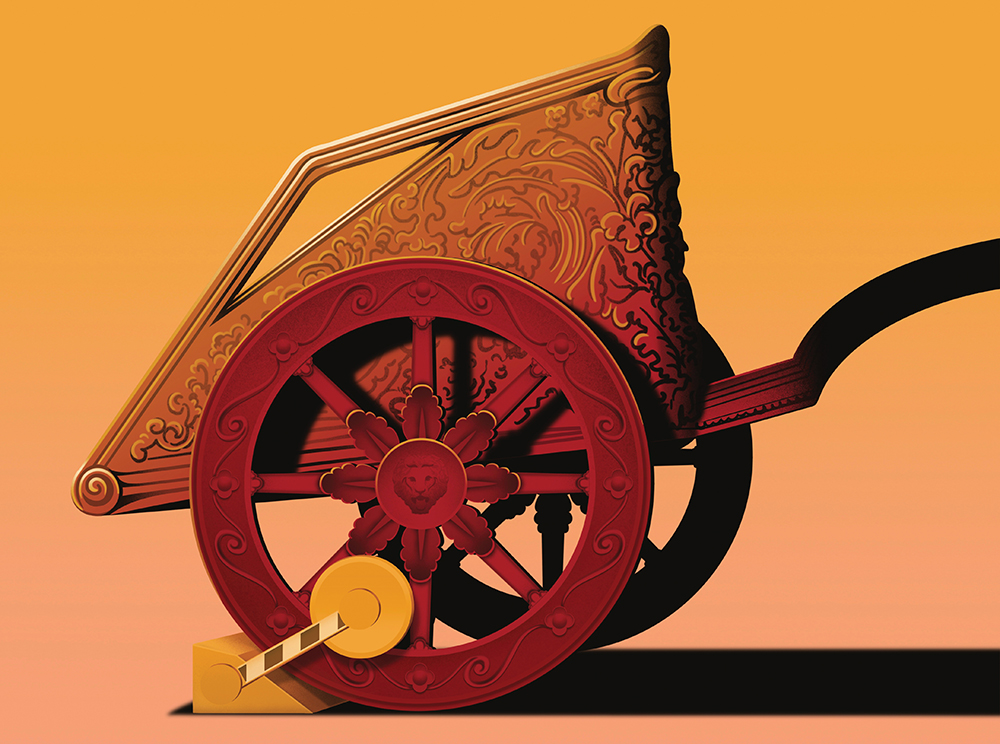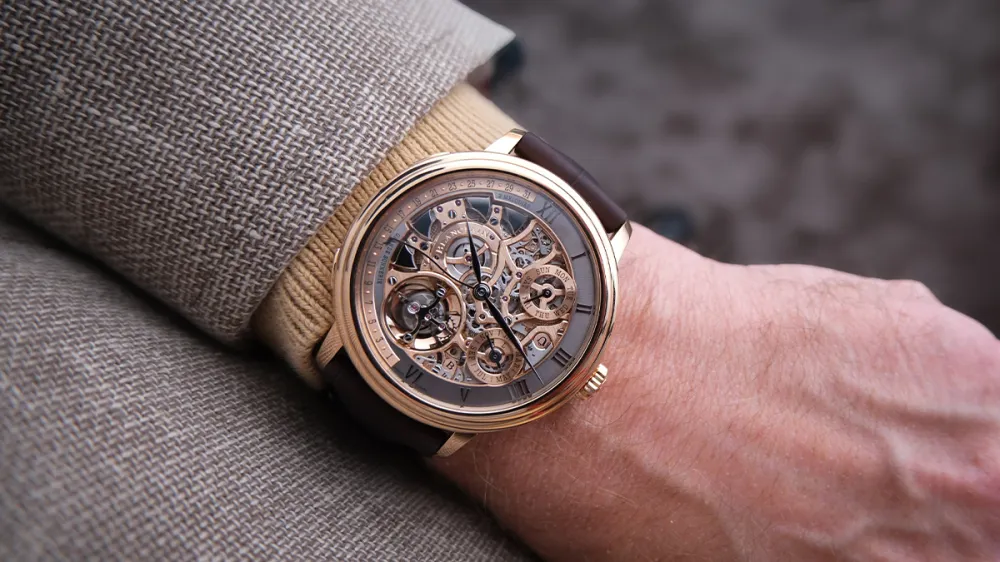
The scene is the invitation-only preview of the European Fine Art Fair, colloquially known as TEFAF, in New York in May. A savvy American collector who has known his way around the art world for decades is admiring a headless torso, gracefully chiseled in marble. All that’s left of the statue’s arms is a rough chunk above the right buttock, believed to be the remnant of a hand. The dealer, an elegant Parisian, carefully rotates the millennia-old figure on its turntable pedestal. “We have photographs of it before 1970,” he rushes to tell the collector—a claim that might sound like a non sequitur to the uninitiated but has become (faulty) shorthand in the antiquities trade for “legal to sell.”
After a recent barrage of headlines about archaeological artifacts seized from humiliated collectors and museums, dealers criminally indicted for trading in smuggled goods, and countries of origin agitating for the return of such pieces, valuable antiquities have become a hot topic, so to speak. It’s no wonder that some collectors are feeling skittish and dealers defensive: Navigating the art world can be daunting enough without the fear of law enforcement knocking on your door with a search warrant.
And yet interest in artifacts—whether from ancient Greece, the Roman Empire, Egypt, sub-Saharan Africa, Latin America, Asia, or Indigenous cultures—hasn’t abated. Unlike past eras, when scholarly collectors prided themselves on being among the foremost experts on narrow categories, today many collectors of contemporary art have begun to pepper their Warhols and Princes with Roman mosaics or Chinese Buddhas. At TEFAF, a handful of plum antiquities dealers are ensconced among the Gagosians and Paces of the world.
It was a contemporary-collecting couple, for example, who were drawn to a large, strikingly colorful image of the Egyptian goddess Amentet on a sarcophagus panel dating to about 700 B.C.E., on prominent display at the stand of Charles Ede. Even their art adviser seemed to be a novice in the category, Charis Tyndall, a director of the London gallery, tells Robb Report as she keeps an eye on browsing fairgoers, “and he said, ‘What questions should I be asking?’ ”
After Tyndall gave the adviser a crash course in condition (the pigment is all original; the wooden backing completely restored by the gallery’s conservator to prevent the plaster from crumbling) and provenance (the dealer has a Belgian certificate of authenticity from 1978, five years before Egypt banned the sale of such treasures), the couple promptly bought the piece, which was listed for about $223,000.
Naivete, combined with high demand and high risk, can produce an explosive cocktail—making the question of how to collect this type of material, both legally and ethically, an urgent one. The answers provided by lawyers, museum professionals, art historians, dealers, and collectors are complex and nuanced. But it’s instructive to first understand how we arrived at today’s precarious moment.
A Matter of Ancient History
For centuries—millennia, really—ancient objects dug out of the ground or plundered in war mostly fell under the heading “finders, keepers.” The Romans carted home countless statues after conquering Greece in the 2nd and 3rd centuries B.C.E. When the British sacked Benin in 1897, they brought along a curator to sift through the ruling oba’s exquisite bronzes.
Attitudes began to change around the turn of the 20th century, at least on the part of colonized countries whose priceless treasures were decorating the galleries and salons of Europe and the United States. In 1906, the Ottoman Empire decreed that all cultural artifacts discovered on its territory belonged to the state, a law that modern-day Turkey has cited in its quest to recover missing material. Other nations followed suit through the course of the century, though some archaeologically rich countries were decidedly late to the game. Before Egypt enacted its ownership law in 1983, one dealer quips, a tourist could buy and legally export an authentic piece of history as a souvenir from a low-rent Cairo gift shop.
As onetime colonies gained independence, awareness of the issue grew, along with concerns among academics that the market was incentivizing the destruction of archaeological sites. The UNESCO 1970 Convention on the Means of Prohibiting and Preventing the Illicit Import, Export and Transfer of Ownership of Cultural Property established unenforceable guidelines, though many erudite collectors and renowned museums weren’t too bothered by such cultural-heritage protections. Thomas Hoving, who served as director of the Metropolitan Museum of Art from 1967 to 1977, boasted in his memoir that his address book was chock-full of “smugglers and fixers.”

Then came the Washington Conference Principles on Nazi-Confiscated Art, in 1998. Though it dealt with a particular regime and era, it had outsize influence on the larger debate and led to a series of bilateral agreements between the U.S. and 29 other nations regarding repatriation of misbegotten art. Soon after, the antiquities field was rocked by a series of scandals: Well-known dealer Frederick Schultz was sentenced to 33 months in prison for trading in stolen Egyptian artifacts; respected Getty Museum curator Marion True was brought to trial in Rome for allegedly conspiring to traffic in looted art (charges were eventually dismissed after the statute of limitations expired); and, perhaps most consequentially, following the U.S. invasion of Iraq in 2003, roughly 15,000 pieces were looted from its National Museum. By 2008, the Association of Art Museum Directors had drafted new rules putting the onus on institutions to research their acquisitions with rigor and to insist on provenances traceable at least as far back as 1970 (the year of the UNESCO Convention), though loopholes remain.
As misdeeds came to light, so too did an unprecedented public inventorying of museum holdings: The digital age saw institutions creating online databases of their collections, giving art lovers and curious foreign governments alike near-instant access to the whereabouts of countless objects. “At that moment, things really shifted because museums were being held accountable in ways that they hadn’t before,” says Victoria Reed, senior curator for provenance at the Museum of Fine Arts, Boston.
“You can’t hold on to stolen looted artwork for very long if your entire collection and the provenance are online—at least, that should be how it works,” she says.
Many museums, the MFA included, ended up returning several pieces to their homelands.
Why Are Antiquities So Dicey Now?
A host of related sociopolitical factors have reframed the field of antiquities in the past five or six years. On a visit to Burkina Faso in 2017, French President Emmanuel Macron acknowledged the magnitude of African artifacts in European museums and vowed to restitute many from France. His speech was a strikingly high-level admission of the unique impact of cultural heritage. Social-justice movements such as Black Lives Matter have also forced many Western nations to reexamine their relationships to former colonies. Demands to repatriate museumgoer magnets such as the Benin Bronzes and the Parthenon Marbles—requests once considered laughable in many quarters—have been gaining traction. The issue has even seeped into the popular consciousness, with the first Black Panther movie featuring a retributive museum heist of Wakandan objects, and comedian John Oliver devoting an episode of his show Last Week Tonight to museums’ refusals to return ancient or sacred objects.
But the weightiest factor may be the Manhattan district attorney’s Antiquities Trafficking Unit and Matthew Bogdanos, its single-minded leader. As a Marine colonel stationed in Iraq when the National Museum was looted, Bogdanos persuaded his superiors to let him investigate. After recovering thousands of purloined pieces, he wrote a book, Thieves of Baghdad, won a National Humanities Medal for his efforts, and returned to the D.A.’s office determined to stop the illegal trade of antiquities.
As a state, not federal, prosecutor, Bogdanos has kept his approach intriguingly simple, relying mainly on New York law governing the possession of stolen goods. In essence, if an object was excavated and exported without a license after a country had a national ownership law in place, said object could be considered stolen property. Under this theory, Bogdanos has seized dozens of pieces from the Met, among them a grand, headless statue widely believed to come from Bubon, in what is now Turkey.
It was Bogdanos’s team that negotiated an unprecedented lifetime ban on collecting in lieu of prosecution for billionaire Michael Steinhardt, who in 2021 also relinquished 180 antiquities worth an estimated $70 million. And it’s his office that seized some 89 items from the collection of Shelby White, a longtime board member at the Met, which has a gallery of Greek and Roman art bearing her name and that of her late husband, Leon Levy. When some of the objects were repatriated to China in May, Bogdanos noted that White had cooperated fully and that prosecutors had found no evidence of criminality on her part—no doubt a measure of comfort in an otherwise humiliating turn of events.
Law and Order
Despite its frequent citation, 1970 is an ethical demarcation, not a statutory one. On the topic of restitution, the American legal landscape is a patchwork of enough dates, bilateral import agreements, and lists of affected material to make most people’s eyes glaze over.
Then there are those foreign-ownership laws, which could render a smuggled object stolen property. “So 1970 isn’t a magic protective shield that’s going to guarantee you’ll never have any headaches from acquiring this piece,” says Elizabeth Marlowe, professor of art history and museum studies at Colgate University.
One assurance that a seller isn’t breaking a national cultural-heritage law is an export license. “However, I’ve never seen an antiquity on the market with a real export permit [from its country of origin],” says the MFA’s Reed, the preeminent provenance researcher according to many expert opinions.
It’s a lesson the Met learned the hard way, when Kim Kardashian posted a photo of herself standing next to a gold sarcophagus at the Met Gala, and online sleuths recognized the piece as one looted from Egypt in 2011. Authorities determined the museum’s $4 million purchase in 2017 had come with a sham export license, printed with a name for Egypt that was obsolete by the year listed. “My opinion is the Met should have been able to figure out it was a fake export license,” says law professor Patty Gerstenblith, director of the Center for Art, Museum and Cultural Heritage Law at DePaul University. “Presumably they have people on staff who can read Arabic and who know the history of Egypt. To me that’s kind of basic. You probably could have found it on Wikipedia.”
The coffin is now back in Egypt, and the Met, after a series of additional embarrassing incidents, announced this past spring that it would beef up its provenance research staff with four additional hires. In an open letter, Met director Max Hollein noted that a tiny fraction of its 1.5 million objects are in question and defended the museum for having a “longstanding history in the rigorous review of our collection and, when appropriate, the return of art.”
The Best Defense Is a Good Offense
Most experts agree that collecting while staying on the right side of the law is possible. The key is to act in good faith and make every attempt to verify that the antiquity in question meets the legal threshold: The days of accepting the assertion, whether from a dealer or an auction house, that an object came from “the collection of a gentleman” are long gone. “Nobody’s ever going to sell you something and tell you there’s a problem,” Reed warns. “So it’s up to the buyer to probe a little bit deeper.”
That’s not always easy. In Gerstenblith’s experience, it’s not uncommon to see an authentic antiquity sold with a made-up history designed to mask its illegal export. “I believe there has been a real growth in fake provenance documentation,” she says. “As the emphasis on providing documentation has increased, there’s more fake stuff out there.”
Several experts say many dealers have responded to the stricter regulations by providing increasingly vague information—namely, obscuring the country of origin. “Everybody might know this object was stolen, but as long as we don’t know who it was stolen from, then it’s [treated as] totally fair game,” Marlowe says. “So UNESCO 1970 didn’t have any teeth. All it did was ensure from that point forward dealers were very, very careful to scrub any information about what the source country is. And they got more and more careful about doing that.”
In dealers’ defense, dozens of modern-day nations now occupy the footprint of the Roman Empire, making exact identification a tall order in many cases (plus, goods were regularly transported and traded). Similarly, pieces from, say, India and Nepal can be hard to differentiate. Tyndall also notes that for years, keeping detailed ownership histories was not standard industry practice unless an item had been in an important collection, which might boost its value; collectors often tossed paperwork. “No one cared,” she says. “Now, of course, the first thing people ask, before they even ask the price, is, ‘What’s the provenance?’ ”

Tyndall spends much of her time on provenance research (“a bore, I have to say”) when she’d far prefer researching the objects themselves. “It’s almost as though there’s been a reversal of the burden of proof,” she grumbles.
Legally, that’s not the case. “The legal standard doesn’t require [buyers] to do anything,” says Tom Kline, a prominent art lawyer who has represented clients across the spectrum of the issue. “Dealers are expected to have a higher standard of diligence, but the average collector is not required to exercise diligence.” Still, he says, it can help: When Kline represented Michael Steinhardt in a well-publicized civil dispute with Turkey over a small figurine nicknamed Stargazer, the fact that “the court found that he was diligent, and Turkey was not diligent”—the piece had long been exhibited at the Met and repeatedly published before Turkey finally sued—aided Steinhardt’s cause. It also helped that Turkey could not prove that Stargazer, which was traceable to 1961, had been illegally excavated after its 1906 ownership law (though the excavation of a looted object is rarely recorded). “It’s far better for the possessor to be able to say, ‘I hired an expert, I checked the literature, I talked to some museums: I followed best practices.’ ”
“What I see is ultra-high-net-worth individuals not understanding the degree of risk that they’re taking on with a purchase,” Kline continues. “It’s not that they’re evil, it’s that the current environment requires more. A collector would be well-advised to hire someone to go through the collection. There’s much more research that can be done than people generally understand. Maybe [the antiquities] went through an auction house or a dealer; maybe they were published somewhere. Get all the documents the seller has. A seller’s identity is often kept confidential as a matter of market practice, and that’s problematic. The seller has privacy rights, but the buyer needs to establish a chain of title when they sell or donate or die and the object goes to their heirs. So we sometimes try to negotiate that the seller will be disclosed after the purchase and only for purposes of use in a resale.”
That ability to offload the object down the line may well require rigorous documentation, particularly as regulations—and mores—fluctuate. “If a collector wants to donate to a museum,” Reed says, “they’re going to have to know what standards the museums are upholding.”
As Kline points out, heirs are often less fascinated by urns and cylinder seals than their parents but get stuck with them. “They have a collection that’s not well documented, and they have to cope with it,” he says. “Objects outlive people, so there needs to be some kind of succession plan. Sell, give, donate, return. Those are the options.” Those, or commit to their being family heirlooms.
Of course, a vague backstory doesn’t necessarily equate with a sordid past; sometimes research can erase any misgivings about an object’s legality. In one case study offered by Reed, an Egyptian limestone sculptor’s model was for sale in 2014 with a scant provenance lacking both an exhibition history and a bibliography. A previous owner was identified as “Meiss Collection, USA, acquired before 1975,” though with neither a first name nor a city. The most compelling tidbit was an inventory number, which “sounded to me a lot like a museum loan number,” she recalls. “I knew the format was familiar, and so I sent inquiries around to a few of our sister institutions, and as it turned out, this piece had been on loan to the Fogg Art Museum over at Harvard as early as 1954. The person who owned it and lent it was the art historian Millard Meiss, who died in 1975.”
“It seemed like this object had no paper trail,” Reed adds. “But in fact, with a little bit of digging, we could construct an ownership history back to 1954. We ended up purchasing it, and it’s now in the collection.”
Gary Vikan, the former longtime director of the Walters Art Museum in Baltimore, suggests taking a photo of the object and sending it to the cultural attaché of any potential source country’s embassy in Washington. “Do your homework, don’t buy the story of the dealer, figure it out for yourself,” he says, adding, “Be prepared to lose.” (Kline warns that disseminating a photo can also open up a can of worms, including a demand for repatriation, even years later.)
Collectors with research chops and ample time could try checking publications, sales records, and exhibition lists on their own. Circumstantial evidence, such as biographical or travel information, can also prove helpful. An independent conservator should be able to assess whether an object has had restoration work, and finding that the style and materials are consistent with, say, 19th-century practices could support claims that the object was unearthed long ago—and not secreted out of the country last month.
There may be other physical breadcrumbs as well. At her TEFAF stand, Tyndall shows me a fascinatingly odd Greek terra-cotta sculpture, circa 3rd century B.C.E., with the head of a beautiful girl, the gaunt chest of an old woman, and the muscular back of a full-grown man. The back also bears signs of having left Italy in the 18th century—remnants of the same red wax that she describes as “their export stamp”—and have therefore been kept in place.
The Real Deal
Sometimes lost in the brouhaha over provenance is the question of authenticity. Beyond the obvious (seemingly valuable pieces being offered online at fire-sale prices), there are plenty of fake items on the antiquities market mistakenly, not maliciously.
“This material has been copied for hundreds of years,” Tyndall notes. “You’d go on the grand tour and you’d buy a tourist trinket. Someone who doesn’t know what they’re looking at might go, ‘Oh look, it’s really old.’ Well, it is—it’s 300 years old, but it’s not 3,000 years old.”
Further complicating matters is the degree of restoration. Tyndall recommends obtaining a condition report. “Most of this stuff has been restored,” she explains. “It’s not a problem, but you don’t want to have an unpleasant surprise when you find that half of your statue has been made up.”
Even seasoned curators and prolific collectors have been duped. One of the more infamous recent cases involved the Museum of the Bible, the passion project of Hobby Lobby’s Green family. Among their missteps was the purchase, reportedly for many millions, of what turned out to be 16 forged fragments of the Dead Sea Scrolls. “They thought that because they were good at business, they would be good at buying antiquities, and they weren’t—they were terrible,” says Vikan, who submitted a proposal for organizing the museum’s program, which was rejected. “They were embarrassed all over the place for buying those Dead Sea Scrolls.”
The fragments eventually underwent extensive scientific testing, which found, among other things, that they were made of ancient leather, not tanned parchment like the authentic examples held in the Israel Museum—and that the ink was applied when the leather was already ancient, not new.
The Ethicist’s Dilemma
For some in the field, certain categories of material are off-limits—period. “I would start with the premise that [we shouldn’t have] objects that are sacred to other communities: Hopi kachina dolls and masks; bodies, like skeletons and skulls; stone sculpture from shrines in Nepal and Cambodia and India; religious icons that were until recently in a small regional church in Italy,” says Marlowe, the art historian. “Objects that are still under worship—I don’t think there’s an ethical way for people to acquire those. That seems like an incredibly obvious thing to say, and yet it hasn’t been how this issue has been thought about, and still isn’t.”
Marlowe suggests that to avoid incentivizing unsanctioned digs and smuggling, one could collect “humble objects where the country of origin is not going to want them back.” Speaking over Zoom, she reaches for a broken chunk of pottery, an amphora handle that was a gift from her dissertation adviser. “He should not have taken it,” she quickly clarifies. “It’s meaningful to me because he gave it to me when I passed my [Ph.D. exam]. Even if I knew where it was from, they’re not going to ask for it back.”
But such commonly found pieces occupy a gray area. Rural Italians have been known to use ancient vessels discovered in their fields to store rice or sugar. “Archaeologists would certainly say humble objects are just as important to the historical record as the big fancy statues, and we don’t want those things leaving their archaeological contexts,” Marlowe notes. “We need those contexts to be as complete as possible in order to extract the maximum amount of historical information.”

For some collectors, committing to appreciate and preserve an artifact passes the ethical test. “History is more fluid than people want to say it is,” says Jack Shear, a photographer and philanthropist. Shear has been a collector of all manner of things since boyhood and, drawn to their history and their awe-inspiring age, began adding ancient pieces to his trove shortly after meeting his late husband, the celebrated contemporary artist Ellsworth Kelly, nearly 40 years ago. First, Kelly gave Shear a Neolithic jade bi, a Chinese disc with a hole in the center, and over time they assembled a small group of the symbols of heaven. Together they also acquired lingams (phallic carvings representing the Hindu god Shiva) from India, Southeast Asia, and Indonesia, and Kelly collected Edina bird stones and banner stones from the Mississippi Valley Basin that are 3,000 to 5,000 years old. “Ellsworth called them the first American abstraction,” Shear says.
Over the past few years, he’s bought a couple of 1st- or 2nd-century C.E. Roman pieces from Galerie Chenel at TEFAF. “Antiquities are a touchstone to the past,” Shear muses. “When you walk by something that’s 2,000 years old, it has to change you in a way.” He says he doesn’t take any extraordinary precautions, instead trusting the vetting process at TEFAF, though he admits, “I don’t know how strenuous it is, and I don’t know if it’s just PR.”
But in his view—and that of several dealers who spoke to Robb Report—the issue of repatriation can be oversimplified and taken to foolish extremes. Shear recently donated 75 Tibetan thangkas dating from the 17th to 19th centuries to Williams, Vassar, and Skidmore colleges, the last of which opens an exhibition of the rolled paintings at the Tang Teaching Museum on August 19. He was irked when a woman came to a public talk and argued that they should be restituted. “And then it’s like, ‘You understand that the Chinese are in Tibet, and they actually destroyed probably at least 80 percent and maybe 90 percent of Tibetan objects when they came in ’59?’ ” Shear says. “There were people fleeing with these thangkas, and the Dalai Lama has said, ‘Thank God for Western collectors who have kept Tibetan culture alive through these artifacts.’ At a certain point it gets a little bit ridiculous.”
Future Imperfect
The cumulative scandals have altered the market. “Pieces with a very good provenance are becoming much more expensive, and those without are becoming much less,” says Tyndall. “There is this huge split.”
But the fallout is also existential. UNESCO’s cutoff year of 1970 is arbitrary, most agree, as are the dates of diplomatic agreements. Should these deadlines govern possession of some of the world’s greatest treasures? Is there a moral defense to holding on to tens of thousands of objects? To giving them back? With the steady migration of peoples, do these ancient artifacts rightfully belong to the world at large?
“My fear is that the counterbalance, mainly the value of museums and, by extent, of collectors, is being lost,” says Vikan, who is president of the Committee for Cultural Policy, a small think tank that advocates for the controlled exchange of cultural property. “There is no counter voice that’s very effective now saying that in a world that’s cosmopolitan, as people cross borders, as ideas cross borders, art should cross borders. It should be done in a regulated and respectful manner.” Tyndall rhapsodizes about living with antiquities, touching them, and laments, “If they aren’t added to, collections die, become stale. People stop studying them, and that’s detrimental to the academic study of the ancient world.”
Shear finds connection through his transcultural, multi-era trove. “An antiquity moves forward when you don’t,” he says. “It shows that life goes on and that objects pass from one person to another and that we are only caretakers of history.”
On a sunny, breezy day in June, I’m strolling along the Left Bank, directly across the Seine from the Louvre, with its innumerable treasures from every corner of the world, when I spot the gallery that was offering the Roman torso at TEFAF. I see the lissome, limbless body through the front window, so I go inside. The rough patches where the head and arms broke away contrast with the smooth stone surface polished by the artist, making the 2,000 intervening years feel viscerally real. It’s a tangible piece of history, and it can be yours for around $650,000.







